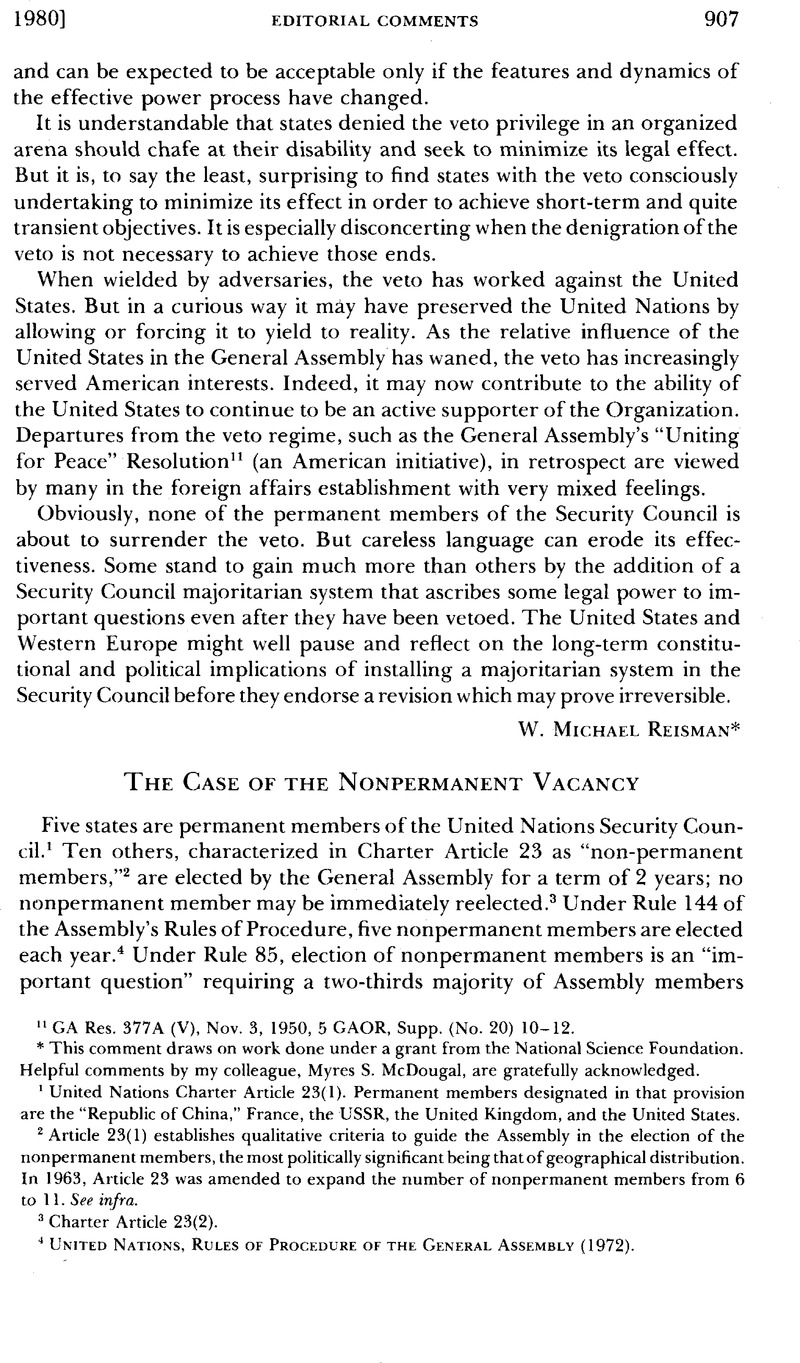No CrossRef data available.
Published online by Cambridge University Press: 27 February 2017

1 United Nations Charter Article 23(1). Permanent members designated in that provision are the “Republic of China,” France, the USSR, the United Kingdom, and the United States.
2 Article 23(1) establishes qualitative criteria to guide the Assembly in the election of the nonpermanent members, the most politically significant being that of geographical distribution. In 1963, Article 23 was amended to expand the number of nonpermanent members from 6 to 11.See infra.
3 Charter Article 23(2).
4 United Nations, Rules of Procedure of the General Assembly (1972).
5 Rule 88, id. at 19.
6 New York Times, Dec. 10, 1979, at 11, col. 1.
7 Id. ,Dec. 18, 1979, at 8, col. 6.
8 Id. ,Dec. 20, 1979, at 11, col. 1.
9 Id. ,Dec. 30, 1979, at 3, col. 2.
10 Id. ,Jan. 1, 1980, at 6, col. 1.
11 Id. ,Jan. 7, 1980, at 2, col. 3.
12 W.,Jan. 8, 1980, at 2, col. 3.
13 Stavropoulos, , The Practice of Voluntary Abstentions by Permanent Members of the Security Council under Article 27, paragraph 3 of the Charter of the United Nations, 61 AJIL 744 (1967)Google Scholar.
14 In addition to voluntary withdrawal, a state that, during its nonpermanent incumbency, became a target of United Nations preventive or enforcement action, could suffer suspension of its rights and privileges under Charter Article 5. That might be construed as vacating its place on the Security Council or as suspending its voting right there. But cf. L. Goodrich, E. Hambro, & A. Simons, Charter of the United Nations 97 (3d rev. ed. 1969). Expulsion in accord with Charter Article 6 would most certainly vacate a nonpermanent member's seat on the Security Council.
15 See note 2 supra and also Suy opinion, UN Doc. A/34/PV.118 (prov.) at 31-32 (1979).
16 GA Res. 1991 (XVIII), Dec. 17, 1963.
17 A legal opinion by the Legal Counsel of the United Nations on this point stated that in the interim the Security Council would not be prevented from operating: United Nations, Juridical Yearbook, 1965, at 224-25.
18 Opinion of Erik Suy, note 15 supra ,at 30 et seq.
19 Id. at 36. In Assembly discussion, subsequent to the presentation of the legal opinion, the representative of Guinea-Bissau sought clarification on the minimum numerical requirement: “What would be the minimum requirement? How about 13 members? Or 12, or 11, or 10, or 9—or only the five permanent members?” Id. at 57. The Legal Counsel did not answer this question, perhaps in response to the signal from the questioner that no answer would satisfy his delegation.
20 Id. at 37-38.
21 See U.S. Dep't of State, The Conference of Malta and Yalta, 1945, at 661-67, 711-12 (1955). See also L. Goodrich, E. Hambro, & A. Simons, supra note 14, at 216-21, and R. Russell, A History of the United Nations Charter 531-40 (1958).
22 GA Res. 377A (V), Nov. 3, 1950, 5 GAOR, Supp. (No. 20) 10-12. Note, however, that the resolution does not authorize recommending armed force for a threat to the peace but only for a breach of the peace or act of aggression. In contrast, the Security Council retains the option of high coercion as one lawful response to a threat to the peace. The general problem of the legal effect of a resolution of the General Assembly is too complex to be entered into in a footnote. While it is not binding in the sense of a decision of the Security Council under Articles 25 and 26 of the Charter, it may achieve a certain substantial legal effect depending on the context.
23 Certain Expenses of the United Nations (Article 17, Paragraph 2 of the Charter), [1962] 1CJ REP. 151.
24 See generally 5 GAOR, 1st Committee, 354th-371st mtgs. (Oct. 9-21, 1950).
25 See UN Doc. A/6717, letter of June 13, 1967, from the USSR. See also UN Doc. A/6718, letter from the United States expressing reservations regarding Soviet use of Uniting for Peace.
26 Opinion of Erik Suy, note 15 supra, at 36.